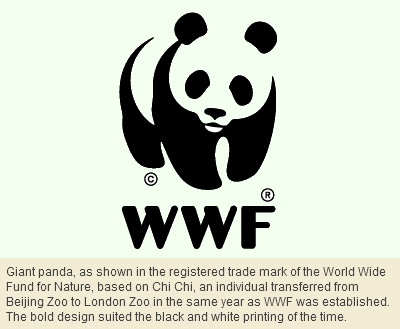Most biologists know that conservation of the giant panda is biased, but we introduce clarity here on three counts. Firstly, part of the bias is for pied colouration. Secondly, this piophilia deserves a name. Thirdly, piophilia seems to have contributed to the salvation of several other large mammals.
We felt creative this morning, after realising that a lack of clarity in our attitude to the giant panda[1] is partly owing to a failure to coin a term for the phenomenon involved. As readers know, it’s hard to think clearly about something without having a word for it.
What we’re talking about is human failure to be scientifically objective in allocating effort to the conservation of species. People can be biased for or against saving species in various ways. One bias is for the kind of appeal that the giant panda has and the desert warthog[2] lacks. Were everything else the same, but the Chinese bamboo-eating montane endemic was like a warthog in appearance, the imaginary ‘wartpanda’ would probably be extinct today. Conversely, were the truly extinct desert warthog of the southern tip of Africa as good-looking as the giant panda, the surviving subspecies might have been reintroduced from Kenya long ago, possibly rivalling the bontebok[3] as the logo of Cape Nature. Instead few have heard of this species of warthog, let alone its extinct subspecies, and that probably won’t change.
A particular unexamined bias is for pied colouration. Tonal contrast is more attention-grabbing and visually exciting than uniform shading. One can spot this bias once conscious of it, but as long as it lacks a name it’ll be only vaguely realised, even by biologists lamenting the disproportionate allocation of funds to the conservation of the giant panda.
So this is our contribution of the morning. Piophilia is the love of pied things as opposed to plain-coloured things. This novel word is nice enough etymologically and resonates interestingly with e.g. pedophilia. Coining ‘piophilia’ for the first time here may help to clarify one non-objective aspect of our approach to conservation in the case of the giant panda, an animal that admittedly has a multifaceted appeal to the human viewer. Unfortunately, the appeal of pied animals may – in the zero sum game of conservation funding – have detracted from the conservation of various equally endangered and equally deserving species out there that lack a superficial and subjective drawcard.
There may be a common theme in our emotional attachment to the conservation of the bontebok, mouflon, banteng and other pied species no more worthy of conservation than others that happen not to be pied, e.g. bluebuck, kouprey, pampas deer and huemuls.
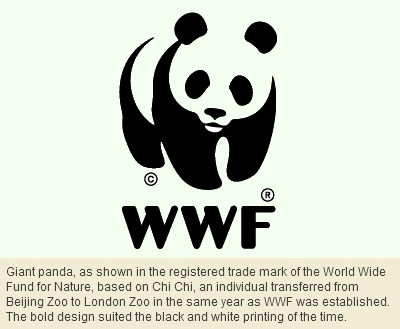
To backtrack again for the sake of perspective: there’s a cognitive dissonance between the appeal of animals and the hard science of animals. Everyone loves animals for their colouration but peer-reviewed biological journals tend to be blind to colouration as an adaptation, possibly because this topic eludes the linear logic of experimental manipulations. Scientists must love colouration as much as the layperson but they keep this a secret as if it’s kid stuff, demeaning of their professional rigour.
Most semi-popular articles, books, videos and films sell animals on their appearance. And much of the appeal lies in colouration. The livid face of the mandrill is a must in any encyclopaedia of mammals. Zebras are a perennial favourite. But the pattern we focus on in particular is that a variegated animal looks more fetching than a plain-coloured one, as spotted by Gerard Manley Hopkins in his 1918 poem ‘Pied Beauty’. Perhaps it’s also no coincidence that the Piper was pied.
Although conservation should be based on scientific objectivity, it is colouration that can make all the difference. If anyone sees the example of the giant panda as mere coincidence, please consider the following.
The bontebok was narrowly spared extinction. By contrast, the coexisting and ecologically similar bloubok[4] was allowed to slip into oblivion, first near the southern tip of South Africa and then again after it had been rediscovered in the Orange Free State. The bontebok survived because one farmer, by the name of van Breda, took enough pride to save one herd on his property at his own expense. The bontebok only just made it. Now that it’s fairly common again, the threat to this subspecies has switched to hybridisation on game farms with its half-heartedly pied nearest relative, the blesbok[5]. We’ll probably care enough to save it once again, this time using genetic testing to discern the pure-bred populations.
We suspect that were the bontebok plain as opposed to pied, it would be extinct. This is the good side of piophilia.
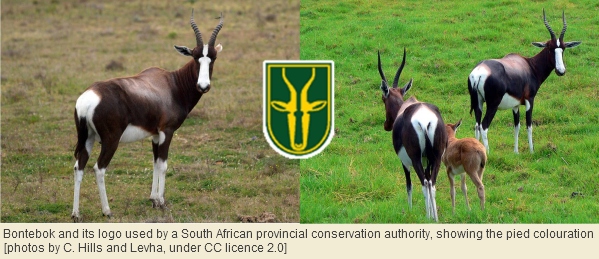
The mouflon[6] is a European counterpart to the bontebok in colouration. This ancestral form of sheep with its obscure origins is now, second to the fallow deer, the most familiar ‘reintroduced’ species of hoofed mammal in conservation estates in parts of Europe. The mouflon is a fairly ordinary-looking sheep except for the fact that it combines a pied pattern with wild-type consistency of colouration, leading us to suspect that this pattern was created by inadvertently selective breeding[7] rather than being found in the true, fully wild, ancestor, whatever that was. Were the mouflon identical to its present form in every other way but plain instead of pied, we doubt that it would exist today. Something similar could be said about the kri-kri[8], which is also pied, derived from semi-domesticated stock artificially introduced[9] to Crete by prehistoric people, subsequently conserved against the odds, and now valued as if it was a surviving example of primeval Europe.
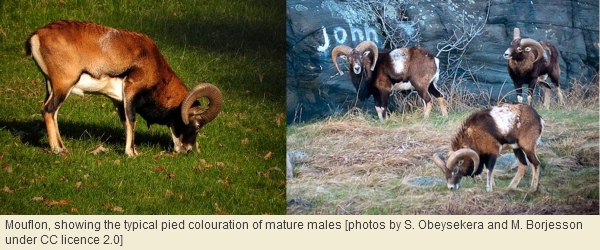
A third example is the banteng[10], the most pied of wild bovines. The survival of this species in its fully wild form in Java is a pleasant surprise given the pressures on wildlife in Indonesia, and contrasts with the extinction of the national animal of Cambodia, the closely related kouprey. In Bali, just across the strait east of Java, the preservation of the pied colouration of the banteng is even more remarkable. Here the most common form of domestic bovine is the domestic form of banteng, but there is none of the individual variation, resulting from selective breeding, that we expect in domestic forms. Instead, the fully domestic banteng of Bali looks similar to the ancestral form still living wild in nearby Java, suggesting that this consistent appearance is maintained by selection by Balinese livestock breeders. Indeed, the extremely docile banteng of the rice paddies is so consistent in colouration with the wild form that it has not been classified as a separate species in the way done for other domestic bovines. What’s more, in its feral form in northern Australia it has been treated as representative of the wild banteng in terms of its ex-situ conservation value. It seems that, once again, human psychology has been swayed by an appealing pattern, perhaps qualifying as a case of piophilia although the Hindu cultural values involved remain to be investigated.

One of the problems with conservation in South America is that most of its hoofed animals are relatively plain-looking. The pampas deer[11] is disappointingly dull compared to e.g. the pronghorn[12]. Perhaps this helps to explain why Argentines, despite their historic affluence and education, have neglected their only once-common deer to the point that the local subspecies could hardly be more endangered were this country as poorly developed as adjacent Bolivia. Similar comments can be made for two species of Andean deer, one of which is the national mammal of Chile but a Cinderella to the rest of the world. Unluckily, both the huemul[13] and the taruca[14] are dull-looking.
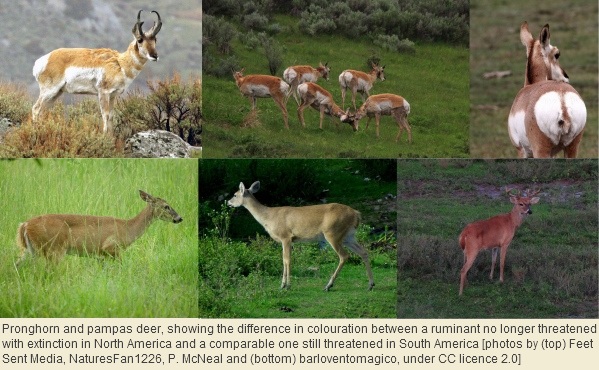
In the case of the giant panda, there’s no doubt that the strenuous efforts to save this species from extinction are based on a dual appeal: colouration that is pied to the point of caricature and an equally fortuitous anthropomorphism in being short-faced, seemingly large-eyed, rotund, and capable of standing bipedally. While we’re as glad as the next biologist that the giant panda has been conserved, there is a cost to this for various other, less appealing species that objectively deserve their share of salvation. As the giant panda benefits from subconscious piophilia, so other endangered species suffer if they don’t play to some other, compensating, bias.
Among the first biological studies that scientists should have made about the giant panda is ‘what is the adaptive value of that colouration?’ And yet we know of no biologist working on this question, either experimentally or by any other approach. If we’re going to be subjective in conserving the giant panda, let’s at least enjoy ourselves in seeking an objective understanding of the biological reasons for its colouration in the first place.
***
All text and images appearing in this blog are subject to copyright, except those images explicitly stated to be in the public domain. You are not free to use any photographs, for any purpose, without receiving written permission from the copyright holder.
1 Ailuropoda melanoleuca
2 Phacochoerus aethiopicus, which includes the extinct subspecies aethiopicus of southernmost South Africa and the surviving subspecies delamerei of Kenya and the Horn of Africa
3 Damaliscus pygargus pygargus, the common name of which comes from the Dutch for ‘pied goat’
4 Hippotragus leucophaeus, the common name of which comes from the Dutch for ‘blue goat’
5 Damaliscus pygargus phillipsi
6 Ovis species or subspecies, of unclear taxonomic status and not adequately described by the adjectives domestic, semi-domestic, feral, or wild
7 For parallel processes in another hortensic form, see our forthcoming e-book chapter on the Indian peafowl and the twinspot goby.
8 Capra aegagrus creticus
9 For an interpretation of a relative of mouflon and kri-kri that really was native to Mediterranean islands, see our forthcoming e-book chapter on the Balearic sheep.
10 Bos javanicus
11 Ozotoceros bezoarticus
12 Antilocapra americana
13 Hippocamelus bisulcus
14 Hippocamelus antisensis
15 our new word for our scientific genre combining rigour and speculation in an electronically mediated series

